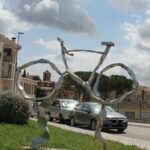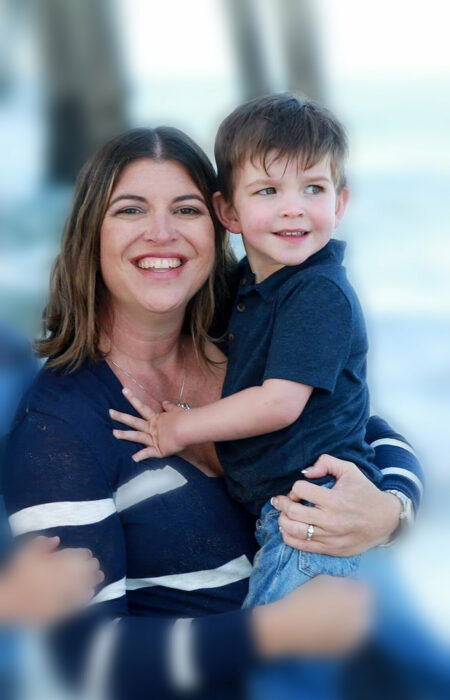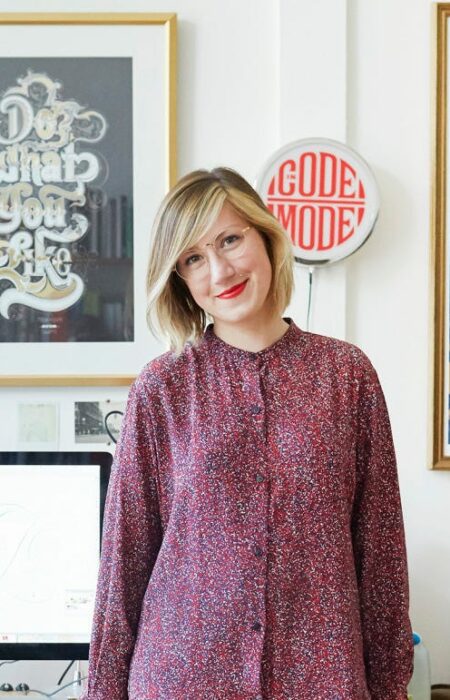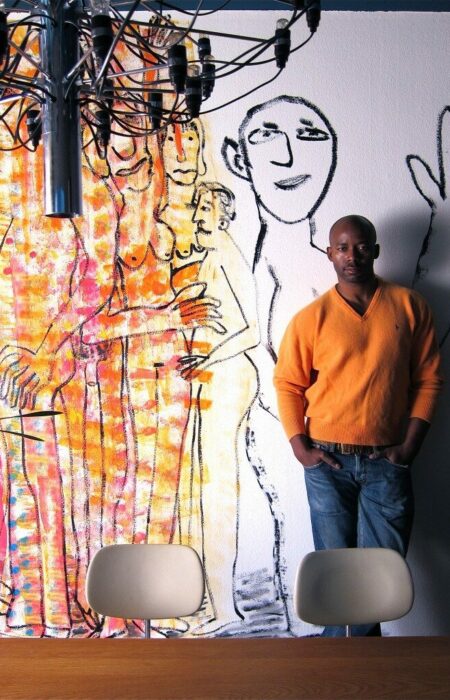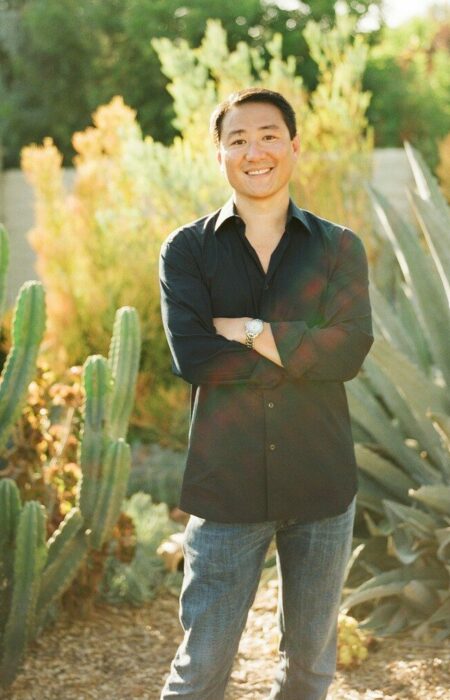Shoe designer Bettye Muller creates vivacious collections that are any shoe lover’s dream. She indulged her love of classic shapes and bespoke details during the start of her design career in London and later returned to her native New York City. Referencing muses she calls Hitchcock Blondes, Bettye imbues her distinctive designs with thoughtful and confident details inspired by everything from vintage fabrics to interior design to travel. With a feminine hand and an unerring sense of proportion, Bettye designs shoes that are beautifully hand-crafted in Italy and Spain and meant to be loved forever.
Postcard in Japanese cotton, Spring 2009 collection by Bettye Muller
I wouldn’t know whether to wear your shoes or set them on the pillow next to me and gaze at them lovingly. What is it that takes your designs beyond an otherwise practical accessory into the realm of art?
Well, it’s funny, first of all, that you ask me that as your first question, because I recently got a card from Nora Ephron, whom I know through my husband. And she just started doing a new play called Love, Loss, and What I Wore. It’s off-Broadway, and there are a lot of wonderful people in it. We went to the dress rehearsal, and I sent her a pair of shoes, because she talks a lot about shoes and loving what she wore all those years. She sent me a card back saying she had actually considered displaying them and not wearing them! But she finally did wear them and got so many compliments. So my shoes are all really wearable, but I guess there’s just something special, an element of surprise. They’re very wearable, but they are art pieces too. So I think about all of that when I’m creating them, but I don’t know exactly what sets them apart — just the material, the color, and the whole thing. I mean, from start to finish, I really think about the design.
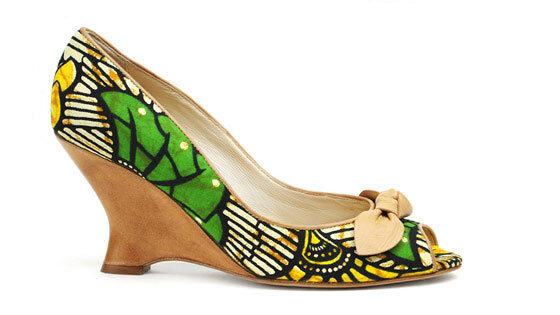
Artifact, Spring 2006 collection by Bettye Muller
Bonham, Fall 2008 collection by Bettye Muller
Variety, Spring 2009 collection by Bettye Muller
How long does it take you to design a pair of shoes?
It depends. It could take anywhere from a few weeks to a couple of months. The thought process and then putting it down on paper — you know, I draw everything out myself and go through a lot of sketches before I really like something. Sometimes it happens instantaneously, and it flows right out. And then I have to select the materials. For the most part now, I’m quite advanced at it, so I know my linings, I know what I’m working with. I actually was maybe even more creative in the very beginning when I first started and had no clue what it meant to put the shoes together. So now that I do and I think about all of those elements, it’s a little bit harder, because I have to think about what is actually practical and wearable and commercial. But you want it to be exciting and different.
And my look is really very classic. So I would say, from the start, I have a classic look to me with a very equestrian type of feel to it, and everything kind of spins from that. I draw it out, and I have to go to the factory I’m working with in Italy, and I kind of put everything through. I don’t actually make the patterns, I have a pattern man — a modellista is what it’s called in Italian. And we’ve been working together for a while, and he knows my look and my hand. I try to do my sketches so that it has my look, which is kind of a long line — not too serious, but a long architectural line to it. And then we go into the sample-making, the first prototype. And then from the first prototype, I decide if I like it or not — though they don’t use the materials that they will eventually use, so it’s just kind of mocked up. And I have to use my vision to say ‘Hmm, is this something I want to keep going with or change the lines, change the heel?’ So it’s quite a long process, and there are a lot of elements that go into orchestrating a shoe. There are so many different components, and they come from different places, so it’s quite interesting. The process is fascinating, and I’m quite passionate about everything, but that’s really what turns me on the most. I’m very hands-on, let’s put it that way!
Memo, Fall 2009 collection by Bettye Muller
Visage, Spring 2009 collection by Bettye Muller
Feature, Fall 2009 collection by Bettye Muller
I understand you had quite an eclectic set of experiences prior to designing shoes. Tell me about your background and early influences and how you came to design shoes.
I was a professional figure skater, not at the highest, Olympic level, but I was a competitive skater. And I think growing up, I just was drawn to shoes and to everything related to footwear. I mean, even as a child, always looking at shoes and in shoe windows in Alexander’s, which was a big department store here in New York. And they used to have tables of shoes made in Italy, and they were tagged together. I would shuffle up to a mirror to look at myself in the shoes — I mean, I was really young, so I’ve had this fascination and love of shoes for a very long time.
I’ve had lots of different careers, but maybe it gets back to the skating and ballet and jazz dancing. I love Mary Jane straps and tap shoes, and I don’t know if it’s all interconnected — it must be. And I collected and wore vintage shoes — and not just shoes but vintage clothing — and I styled my whole look around my shoes. Even when I was in my early teens, I bought a pair of shoes in a thrift store that were cleats for golfing, and I took the cleats out and wore them like brogues. I wore them with a men’s jacket. I mean, I’m going way back, but I think it really started early, early on. It’s a love that so many women have, but mine took me into a whole other world.
Golf, Fall 2008 collection by Bettye Muller
I never studied shoe design. I was a graphics and fine arts major in college and then went into acting after that. I was acting, and a woman I knew just from my apartment building in New York asked me if I wanted to do some shoe modeling on the side. So then I became a shoe model, and I worked for a man who said ‘god, I love your style, and I love that shoe you’re wearing — and can I copy it?’ And then it was one thing after the other, and I ended up working for him full-time and then segued into my own business but had a lot of stops and starts and worked for other people along the way.
I lived in London with my uncle who was a photographer in maybe the late ’70s or early ’80s, and really was just trying to hone my eye and be a shoe designer. So I had this experience with this one gentleman doing the shoe modeling, and I worked for him for a while, and then I kind of thought I could start my own business and moved to live with my uncle in London for a year. And I just kind of said, ‘OK, what shoes do I want to do first?’ I’ve always been very attracted to menswear-inspired shoes but with a feminine kind of twist. So, of course, I would comb Jermyn Street and all the streets of London where they had bespoke clothing and menswear and kind of started to do drawings. And my uncle said, ‘Well, you know, you should really meet this friend of mine, and he can really show you how to draw to spec. And one thing after another, that’s how it really went along.
Lounge, Fall 2008 collection by Bettye Muller
Tap, Fall 2006 collection by Bettye Muller
Purdy, Fall 2006 collection by Bettye Muller
You say that your shoes are like Hitchcock Blondes and that each pair tells a story. How did that general inspiration come about, and are you using these references simply as a starting point or does that muse inform the details all the way through the design process?
I think mystery is kind of an inspiration to me. I like a little mystery, and I’m kind of tainted by that noir allure, you know? I really like that, and I love those kinds of movies. Of course, I love Alfred Hitchcock. But I use that as an example, because those are kind of iconic things for me, reference points. I would say I have a certain someone or a look in mind as a muse every single time I do a collection. Whatever I like at the moment, I kind of use her. That’s one of my favorite things to do, I just love looking at old magazines of any type — old Town & Country or Mirabella or Architectural Digest — I mean, anything. So whatever sparks me for that season, I try to get a woman who has that look, that allure that I like. Then I go from there. So a lot of times they are sort of that Kim Novak look, those women that I really love, and I use that as a point of reference.
Gustav, Fall 2006 collection by Bettye Muller
Edie, Fall 2007 collection by Bettye Muller
Bardot, Spring 2008 collection by Bettye Muller
Chaise, Spring 2007 collection by Bettye Muller
Capri, Spring 2008 collection by Bettye Muller
Skyline, Fall 2008 collection by Bettye Muller
You come up with some incredibly creative and offbeat touches, taking classic shapes and giving them a real twist or element of surprise. Tell me how these rich and unexpected details come about.
I would say that they’re kind of more decorative details than minimal. I’m very classic, and those inspirations that I always love — whether it’s Lake Placid or Palm Beach — it’s that rich, luxury look. And then whatever shape I’m doing, I try to make a nice balanced shape, not too crazy here or too crazy there. And I kind of build on that, and I decorate. I wouldn’t say I’m just a decorator of a shoe, because there are a lot of people who just throw stuff on a shoe, and mine have a lot of thought behind it.
You know, sometimes my shoes are very cleaned up in a season when everything is so decorative, and I’m already onto the next thing and I don’t want to be that way anymore. I’m trying to do clean lines, and people say, ‘Well, I don’t know about that.’ So I feel like I’m always just a bit ahead of myself in the things that I like and the details that I use.
I love interior design, and I look at that for inspiration too. My husband and I have a home in Westchester that we go to on weekends, and it’s a 1790s farmhouse, and we have kind of completely been redoing it. And I guess a lot of those details come into play on the shoes. It’s just unfortunate that a shoe is so small! You know, sometimes I have maybe five ideas on a shoe, and it’s too much — you know, they could be five different shoes.
Christie, Fall 2007 collection by Bettye Muller
Musk, Spring 2006 collection by Bettye Muller
Colette, Fall 2008 collection by Bettye Muller
Some of your shoes incorporate textile designs like ikat and African motifs, and you mentioned your love of interior design. Is there kind of a central inspiration for an entire collection or do you have multiple inspirations?
I have multiple inspirations, I really do. But I would say travel — and I’ve traveled extensively — is a large part of it. And I’m like a fabric-holic — I can’t get away from fabrics. I dream that I could design fabrics, and I have a collection of fabrics too. And not just fabrics — in our house we use de Gournay wallpaper in one room, and that inspires me too. It’s hand-painted on silk, and it’s just beautiful — there’s just nothing like it. There are copies of it, but the real thing is the real thing. Shortly after I had done the de Gournay wallpaper, I did a shoe with some fabric that looked like it, and the whole collection was kind of wallpaper-inspired, I would say. And that’s kind of how things cross over and happen. One day it finally all comes together. It’s so not clear-cut.
Artifact, Spring 2006 collection by Bettye Muller
Ruby, Spring 2007 collection by Bettye Muller
Bonham, Fall 2008 collection by Bettye Muller
Ritz, Spring 2008 collection by Bettye Muller
You mentioned your menswear-inspired shoes, which are killer! How are you doing this in a way that still feels feminine and playful?
You know, I guess my hand is always a bit feminine. And I like those butchy things, I really do! I’m a jeans and t-shirt girl, and I’ll wear Converse sneakers a lot, but I know now I have to kind of tame it down for the market that I’m selling to. I did do a lot of menswear last year, and nobody bought it. The only ones who really wanted it were Bergdorf Goodman. Now this year, everybody’s doing menswear-inspired shoes. You know, they were feminine and everybody said so, but now I’ve done another take on it, because I can’t go back to what I did last year — I don’t like to do that, so I’ve kind of spun it a little differently. But I love menswear, and I think that’s probably a big part of every collection that I do. A little tailored, but I still have a feminine hand. When I draw and design, it doesn’t come out heavy. I try not to be too trendy so that you won’t even be able to look at it next year. I try to do things that now or ten years from now, you pull them out and look at them and know it’s a great style.
Ghillie, Fall 2008 collection by Bettye Muller
Brummel, Fall 2008 collection by Bettye Muller
Foreman, Fall 2008 collection by Bettye Muller
Tuxedo, Fall 2008 collection by Bettye Muller
Your shoes make such a statement, a woman could totally get away with wearing them with just a pair of jeans and a white t-shirt. What sort of customer is drawn to your work?
She definitely has confidence, because she’s not a label-lover. She’s just someone who can really put it together with a little bit more flair. I have a very large crossover of customers, from younger girls who kind of like my style — and they’re very kind of funky and downtown — to older women. So it’s really not just one customer. I’m not for everybody, but I would say there’s a real big cross-section of customers.
Prudence, Fall 2009 collection by Bettye Muller
Rainbow, Spring 2009 collection by Bettye Muller
Harmony, Fall 2007 collection
Circuit, Spring 2009 collection by Bettye Muller
You consistently design shoes with the most perfect proportions — bad proportions are really kind of a deal-breaker for me! Are you hitting the right proportion from the start, or do you find yourself having to rework designs to get it spot-on?
No, I try not to rework it too much. If you have to rework it a lot, it’s not happening. I go to Italy a lot, and now I’ve added Spain to the mix because I’m doing a whole collection of espadrilles. They’re a little bit less expensive, because people are really looking for price, price, price now. And although my shoes are really not expensive, even at $350 or $400, it’s hard for a lot of people to get to. So last summer I started a whole collection of espadrilles in Spain, because Spain is so great — it’s what they do. And that really took off — they did amazingly well.
So I would say between going to Spain and going to Italy, I’m traveling to factories ten or eleven times a year. But when I’m not there and they send me the prototypes, they have to be corrected. So I make corrections on things, and then I send them back, and then they correct them. And, you know, it’s a three or four step process before you go into the final sample making. And those samples may need corrections too, but you want to have a good sample. If you don’t have a good sample, you’re not selling anything anyway!
Slate, Spring 2006 collection by Bettye Muller
Twirl, Spring 2009 collection by Bettye Muller
Poet, Spring 2009 collection by Bettye Muller
Crystal, Spring 2009 collection by Bettye Muller
Katy, Spring 2009 collection by Bettye Muller
So you’re as involved with the manufacturing process as you are with the design part?
Yes. The leather is tanned in Italy, the hides are from Brazil, and there are a lot of different aspects. And that’s the part I love. I don’t want to have to be running to China to make shoes — I want to make beautiful shoes, and it’s hard enough right now as things are with the economy. And every customer and buyer, they ask price, price, price. Even though it’s across the street, I can see if a shoe is made from a terrible piece of leather. This has my name on it, and I just really feel like I want to continue doing really special things. So it’s really hard to hit that fine balance of where you have a really nice product and it’s the right price too. It’s a challenge.
Just from my perspective, even though everybody is very price-conscious, I think people are really looking for things that they just love — that they can love for, as you say, ten years or more, and it doesn’t feel like a throw-away item.
Yes, I love the craft of making shoes. I’m very, very involved in all the steps. And if I were to make shoes in another country — and I have worked in a lot of other countries for different people — I worked in Korea, I worked in Brazil, I’ve worked in Taiwan, and I know China’s been getting huge in the last six or seven years. And the shoes are looking really good out of China — I mean, I’ve seen some amazing product, but it’s not as hands-on. I just don’t feel that they have that creative take — I can’t really explain it as well as I would like to. I’m making things by hand-made factories in Italy. I mean, they’re not even as hand-made as before and they’re losing a lot of ground, I have to admit, but I don’t want to lose that whole feel to it.
Well, it’s kind of part of their DNA in Italy and Spain, really.
Yeah, it is! And I might be like the last one kicking and screaming!
Socialite, Fall 2008 collection by Bettye Muller
Rita, Spring 2009 collection by Bettye Muller
Saloon, Fall 2006 collection by Bettye Muller
Tell me about the sales end of your business. Do you have your own shop or are you selling only through other retailers?
I do have a sales showroom here in New York, but I sell to other stores, and I sell internationally. And I would say right now, I am doing a much bigger business online. I have my website, but I’m not set up for e-commerce. Zappos is one of the retailers that buys my collection, and I’ve talked with them about distributing for me. I think really today, that is something you have to really look at. I’ve got the online business and the specialty stores. The department stores are rethinking too, because they can’t buy things too far in advance like they have been because people can’t wrap their minds around it yet. So everything is changing, changing, changing. And it doesn’t mean I haven’t always wanted to have my own store with my own look — in my head I have it! — but right now I don’t have a store. So I have my showroom here at West 57th Street, and I work out of here. And I do international shows in Milan and Paris and Las Vegas and New York.
Bettye at work in her New York showroom
Do you have any advice for young people just getting started in a creative field?
Yes, I love to mentor young people, I really do. I have an intern working for me now, though she can only give me a few hours a few days a week because she’s really in the thick of things at F.I.T. I really try to encourage them to be creative, but I’ve noticed a lot of young people don’t want to go through all the steps that it takes. You know, I have built and built on this, and it’s something that I’ve been doing for twenty-something years. And I also thought after working for the one gentleman, ‘I’m going to go do my own business.’ But you’ve got to take all the steps and not get too crazy. If you have a little success, that doesn’t mean that you’re not going to get knocked back down a few pegs. You have to keep pushing, pushing through.
Honestly, some of these young people I see are so fast on the computer — they’re just whizzes at that — but they can’t sit down and really put things together, write things out and draw things out. And I always say that’s how you have to start. The basics, the basics. You have to. You know, they have the CAD/CAM and all these products that let you design shoes, and it may show it three-dimensionally, but that is not what you’re going to do when you go into a shoe factory. But, see, this is changing too. A lot of these young people, they go design for somebody, and they’re not going to go to a shoe factory, they’re not going to experience the things I have. They’re going to go work for somebody who’s going to send stuff over to China, and there’s a little extra top-lift on the heel by mistake that they drew, but the manufacturer is going to put that on there. So I just tell them to keep pushing through all that and really learn every aspect of the business if they really want to have their own company.
Rider, Fall 2009 collection by Bettye Muller
What are some of your favorite things, whether they impact your work directly or just make you happy?
Oh, well! I think I said in the beginning that I just love sitting down and looking at this one little black box that I always go back to, and it has tear sheets that I’ve had forever, and there’s always something new that sparks. Old magazines, and — this is going to sound silly — but I love taxidermy and antlers and deer. And fabrics really excite me. And I love being outdoors, either at our house in the country or I love the beach. Those things just really make me so happy, just being outside all day in the air. There are so many things… I love food! I could go on and on about food all day. If I’m not eating, I’m thinking about what I’m going to eat, so that makes me really happy! And I’m thin my whole life, thank God, but I do love, love, love to eat! I love galleries and travel — once you’re there, it’s great, but the whole getting there not so much, probably because I travel so much. I would say those are the most important things.
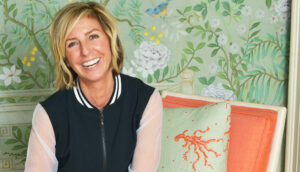
Bettye Muller
Note: Shoes from past collections, though they may no longer be available, are shown here to accompany certain points in our interview and to showcase Bettye’s range of work over time. To view Bettye’s most recent collection and to see what retailers carry her line, visit her website.
Share the love, post a comment!


